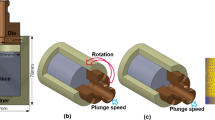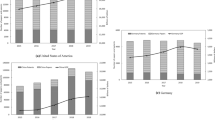Abstract
In this program, the capabilities of medium-frequency direct current (MFDC) electric servo resistance welding guns for the welding of complex stack-ups were investigated. Capabilities of interest from these guns include the ability to apply forge forces and currents, as well as the ability to sequence the current and forging profiles. The complex stack-up under study included a 1-mm outside sheet attached to two 2-mm sheets. Work was done using design of experiment (DOE) techniques. The experiment included a range of processing variations deliverable from the MFDC servo-gun, as well as two electrode variations (materials and sizes). Heat balance during resistance welding of this stack-up was found to be dominated by the electrode variations. As electrode variations are not considered a solution for automotive complex stack-up applications, a best practice was defined from the DOE that included similar-sized class 2 electrodes. This best practice included short overall weld times, a moderate forge force, a significant (40 %) increase in current during forging, and a weld time relative to the forging portion of the weld schedule. This yielded nugget penetrations of roughly 50 % into the thin attached sheet. It was noted that, at these penetrations, indentations on both sides of the joint reached 0.45 mm and that process variations could be used to trade off penetrations with overall indentations.







Similar content being viewed by others
References
Dinda S, Diaz R (1995) The partnership for a new generation of vehicles (PNGV) and its impact on body engineering. Proceedings of the IBEC 95, Advanced Technologies and Processes, IBEC Ltd., pp 5–8
Crooks MJ, Miner RE (1996) The ultralight steel auto body program completes phase I. Journal of Metals 48(7):13–15
Bleck W (1996) Cold rolled, high-strength sheet steels for auto applications. Journal of Metals 48(7):26–30
Resistance Welder Manufacturers Association (2003) Resistance welding manual, 4th edn. Resistance Welder Manufacturers Association, Miami
Welding Handbook, 9th Ed (2007) Welding processes, part 2, Vol. 3rd edn. American Welding Society, Miami, pp 1–48
Auto-Steel Partnership (2008) A/SP starting resistance spot weld schedules for AHSS. Auto-Steel Partnership, Detroit
Lu F, Karagoulis MJ, Dong P (2000) The influence of different sheet combinations on nugget development during resistance spot welding of thick stack-ups. Sheet Metal Welding Conference IX, Detroit AWS Section, Detroit, Paper 1-4
Fong M, Tsang A, Ananthanarayanan A (2000) Development of the law of thermal similarity (LOTS) for low-indentation cosmetic resistance welds. Sheet Metal Welding Conference IX, Detroit AWS Section, Detroit, Paper 5-6
Agashe S, Zhang H (2002) Selection of schedules based on heat balance in resistance spot welding. Sheet Metal Welding Conference X, Detroit AWS Section, Detroit, Paper 1-2
Anderson C, Wiermaa C, Morel MK (2000) Developments in resistance spot welding. Practical Welding Today 4(6):38–40
Slavik SA (1999) Using servo-guns for automated resistance welding. Welding Journal 78(7)29–33
Barthelemy P (2004) Servo weld gun—present and future. Sheet Metal Welding Conference XI, Detroit AWS Section, Detroit, Paper 3-7
Grimes P (2006) Advantages of using servo force control when resistance welding aluminum sheet metal. Sheet Metal Welding Conference XII, Detroit AWS Section, Detroit, Paper 6-2
Lehman LR, Gould JE (1994) A study of resistance spot welding manufacturability using design-of-experiments. International Body Engineers Council (IBEC) 94 Proceedings, Advanced Technologies and Processes, IBEC Ltd., Warren, pp 154–163
Lehman LR, Gould JE (1995) A design-of-experiments evaluation of resistance spot welding manufacturability—part 2: multiple factor effects. IBEC 95 Proceedings, Advanced Technologies and Processes, IBEC Ltd., Warren, pp 88–99
Lehman LR, Gould JE (1996) A design-of-experiments evaluation of resistance spot welding manufacturability—part 3: optimization and process robustness studies. IBEC 96 Proceedings, Advance Technologies and Processes, IBEC Ltd., Warren
American Welding Society (2002) Recommended practices for test methods for evaluating the resistance spot welding behavior of automotive sheet steel materials. AWS/SAE D8.9M:2002
Gould JE (1994) Modeling primary dendrite arm spacings in resistance spot welds, part 2—experimental studies. Welding Journal Research Supplement 73(5):91s–100s
Diamond WJ (2001) Practical experiment designs for scientists and engineers, 3rd edn. Wiley, New York
DeGroot MH (1986) Probability and statistics, 2nd edn. Addison Wesley, Reading
Ahrens WH, Cox DJ, Budhwar G (1990) Use of the arcsine and square root transformations for subjectively determined percentage data. Weed Science 38(4–5):452–458
Osborne J (2002) Notes on the use of data transformations. Practical Assessment, Research & Evaluation 8(6). Retrieved from http://PAREonline.net/getvn.asp?v=8&n=6
Acknowledgments
The EWI acknowledges the contribution of the State of Ohio, Department of Development and Thomas Edison Program, which provided funding in support of Edison Technology and Industry Center Services.
Author information
Authors and Affiliations
Corresponding author
Additional information
Doc. IIW-2275, recommended for publication by Commission III "Resistance Welding, Solid State Welding and Allied Joining Processes"
Rights and permissions
About this article
Cite this article
Gould, J., Peterson, W. & Cruz, J. An examination of electric servo-guns for the resistance spot welding of complex stack-ups. Weld World 57, 243–256 (2013). https://doi.org/10.1007/s40194-012-0019-x
Received:
Accepted:
Published:
Issue Date:
DOI: https://doi.org/10.1007/s40194-012-0019-x




